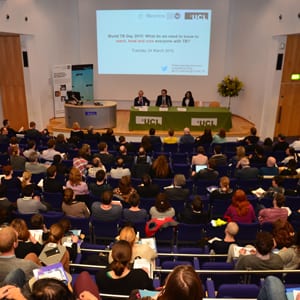Reducing tuberculosis in London and beyond: the woodpecker and weasel approach
By ucyow3c, on 27 March 2015
![]() Written by Catherine Smith, UCL Infection and Population Health PhD student
Written by Catherine Smith, UCL Infection and Population Health PhD student
 Many people are surprised to learn that the problem of tuberculosis in London is so serious that it is now known as the ‘TB capital of Europe’. In the worst affected London Borough of Newham, more than one in every thousand people is diagnosed with the disease each year, and the trend is increasing.
Many people are surprised to learn that the problem of tuberculosis in London is so serious that it is now known as the ‘TB capital of Europe’. In the worst affected London Borough of Newham, more than one in every thousand people is diagnosed with the disease each year, and the trend is increasing.
I live in Islington, where the situation is not quite as severe. However, it is still alarming to note that the rate here is much closer to that of relatively high incidence countries, like Bosnia and Herzegovina and Brazil, than the USA or Sweden.
London is also a major hub for TB research. On 24 March, the 133rd anniversary of the discovery of the pathogen that causes the disease, researchers from UCL and the London School of Hygiene and Tropical Medicine jointly hosted an event that asked the question: What do we need to know to reach, treat, and cure everyone with TB? The event was attended by 270 people, and watched online by over 1,300 from 46 different countries via a live stream.
What is the worldwide problem?
Throughout the day we were presented with a series of astonishing statistics about the global burden of TB. For example:
- Every day, 4,000 people around the world die from TB – at this rate, it would take just four days to wipe out the entire undergraduate student body of UCL. After a further five days, the hardier postgraduates such as myself would also be gone.
- 1% of the population in South Africa develop active TB disease each year – a truly colossal epidemic coined the ‘Kilimanjaro effect’ by Dr Stephen Lawn in the second plenary session.
Although TB is treatable, several features of its pathology and epidemiology pose particular challenges to the control of the disease. Some of these were highlighted over the course of the day:
- Most people who are infected with TB will never show any symptoms of disease – it is therefore difficult to know who to target with preventive treatment.
- TB disproportionately affects people who are HIV positive and those living in conditions of social deprivation – successful control of TB therefore also depends on combating the HIV epidemic and wider issues of equality and social justice.
What is being done about it?
The World Health Organization this year announced its End TB strategy, with an ambitious vision for zero TB deaths, disease and suffering by 2035. At the current rate of decline, it will take more than 150 years to achieve this. Shortening this time period will clearly require major improvements in TB control.
One exciting development was presented by Professor Anne O’Garra from Imperial College London. Her novel research uses ‘transcriptional profiling’ to identify signatures left by human immune responses to the TB pathogen in the blood. Crucially, it also shows promise in distinguishing which infected people are most likely to go on to develop symptoms.
What can I do?
As with all research agendas, maintaining political will and securing investment for TB research requires strong advocates. Actress Emma Thompson and her son Tindy, a former TB patient, have released a powerful video helping to do just this. Aaron Oxley from RESULTS UK also talked about the importance of raising awareness at a local scale, for example using statistics from Public Health England’s excellent tool.
What next?
One of the most engaging parts of the day (in spite of being scheduled in the infamously challenging post-lunch slot) was a debate about the priorities for future TB research.
First, Professor Andrew Hayward of UCL argued that novel tools are key. He made the case that TB elimination is not possible with the currently available interventions, and highlighted the need for a better vaccine; less toxic treatments, and improvements in methods to predict who will develop symptoms.
Second, Dr Delia Boccia from LSHTM contended that TB can only be reduced by focusing on the social determinants of the disease. She pointed out that TB was declining in Europe and North America before any interventions were introduced. TB decline should therefore go hand in hand with achieving universal health coverage and social protection.
Ultimately, Prof Hayward ‘lost’ the debate, with about two thirds of the audience voting in favour of addressing social determinants. Aside from this making me grateful that he is my PhD supervisor and not my MP, I think it is fair to say that neither side really disagreed with the other on this topic.
Or, as Dr Lawn memorably put it, these interventions – much like the woodpecker and weasel – are better together than in isolation.
Watch all sessions from World TB Day at UCL:
Session one – Introduction
Session two – Global Strategy
Session three – Debate
Session four – National Strategy
Session five – Clinical Trials
One Response to “Reducing tuberculosis in London and beyond: the woodpecker and weasel approach”
- 1
 Close
Close


Fantastic lectures during World TB Day at UCL 24th March 2015